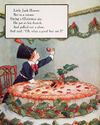
ONE of the very earliest and truly earnest parental instructions I received as a small boy in rural Gloucestershire concerned the most dangerous plant to be found in the countryside, its leggy upward sprawl embracing garden and hedgerow shrubs, its black fruits perilously poisonous and never to be touched, let alone tasted. Its very name struck a chill: deadly nightshade. I still take half a step back when I encounter it. This was not village folklore—every part of the plant is toxic. Two berries can kill a small child, a dozen or so an adult. A single leaf can be fatal. It is one of the Solanaceae family and, although the Latin etymology is unclear, reflecting a preference for shade and the habit of night flowering, above all, it echoes centuries of dark history.
These plants were well known in the ancient world. In war, Roman archers used the juice of the deadly nightshade to poison their arrows. In peace, it was a favoured means of assassination. Agrippina the Younger, mother of Nero, used it to get rid of her husband, Emperor Claudius; Livia, wife of Emperor Augustus, contrived widowhood by the same means.
The potential of its Mandragora relatives —native to the Mediterranean region and called (via the French main de gloire) mandrakes in this country, because the twin root looked rather similar to the human figure —was equally recognised, although they were usually employed for less sinister purposes. In the 4th century BC, the Greek botanist and philosopher Theophrastus recommended root extract for wounds, gout, sleeplessness and as a love potion. The plant was also associated with Dionysus, god of wine, and worshippers achieved drunken ecstasy with mandrake-infused wine.
Diese Geschichte stammt aus der September 07, 2022-Ausgabe von Country Life UK.
Starten Sie Ihre 7-tägige kostenlose Testversion von Magzter GOLD, um auf Tausende kuratierte Premium-Storys sowie über 8.000 Zeitschriften und Zeitungen zuzugreifen.
Bereits Abonnent ? Anmelden
Diese Geschichte stammt aus der September 07, 2022-Ausgabe von Country Life UK.
Starten Sie Ihre 7-tägige kostenlose Testversion von Magzter GOLD, um auf Tausende kuratierte Premium-Storys sowie über 8.000 Zeitschriften und Zeitungen zuzugreifen.
Bereits Abonnent? Anmelden

Save our family farms
IT Tremains to be seen whether the Government will listen to the more than 20,000 farming people who thronged Whitehall in central London on November 19 to protest against changes to inheritance tax that could destroy countless family farms, but the impact of the good-hearted, sombre crowds was immediate and positive.

A very good dog
THE Spanish Pointer (1766–68) by Stubbs, a landmark painting in that it is the artist’s first depiction of a dog, has only been exhibited once in the 250 years since it was painted.

The great astral sneeze
Aurora Borealis, linked to celestial reindeer, firefoxes and assassinations, is one of Nature's most mesmerising, if fickle displays and has made headlines this year. Harry Pearson finds out why

'What a good boy am I'
We think of them as the stuff of childhood, but nursery rhymes such as Little Jack Horner tell tales of decidedly adult carryings-on, discovers Ian Morton

Forever a chorister
The music-and way of living-of the cabaret performer Kit Hesketh-Harvey was rooted in his upbringing as a cathedral chorister, as his sister, Sarah Sands, discovered after his death

Best of British
In this collection of short (5,000-6,000-word) pen portraits, writes the author, 'I wanted to present a number of \"Great British Commanders\" as individuals; not because I am a devotee of the \"great man, or woman, school of history\", but simply because the task is interesting.' It is, and so are Michael Clarke's choices.

Old habits die hard
Once an antique dealer, always an antique dealer, even well into retirement age, as a crop of interesting sales past and future proves

It takes the biscuit
Biscuit tins, with their whimsical shapes and delightful motifs, spark nostalgic memories of grandmother's sweet tea, but they are a remarkably recent invention. Matthew Dennison pays tribute to the ingenious Victorians who devised them

It's always darkest before the dawn
After witnessing a particularly lacklustre and insipid dawn on a leaden November day, John Lewis-Stempel takes solace in the fleeting appearance of a rare black fox and a kestrel in hot pursuit of a pipistrelle bat

Tarrying in the mulberry shade
On a visit to the Gainsborough Museum in Sudbury, Suffolk, in August, I lost my husband for half an hour and began to get nervous. Fortunately, an attendant had spotted him vanishing under the cloak of the old mulberry tree in the garden.